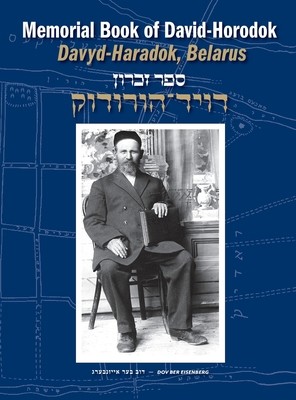
- We will send in 10–14 business days.
- Publisher: JEWISHGEN.INC
- ISBN-10: 1954176988
- ISBN-13: 9781954176980
- Format: 21.6 x 27.9 x 2.9 cm, kieti viršeliai
- Language: English
- SAVE -10% with code: EXTRA
Memorial Book of David-Horodok (Davyd-Haradok, Belarus) (e-book) (used book) | bookbook.eu
Reviews
Description
Davyd-Haradok was a small town in southwestern Belarus in a swampy, sparsely populated area that stretched along the Belarusian-Ukrainian border, just under 50 miles from Pinsk. The history of its Jewish community dates back to at least the seventeenth century and ended with the Holocaust.
After the second partition of Poland in 1793, the regions encompassing Davyd-Haradok were cut off from Poland and annexed to Czarist Russia. It again became part of Poland after World War I when that country was reconstituted as an independent nation. After the Nazi occupation during World War II, the Soviet Union captured the town from the Germans and controlled it until Belarus emerged as an independent state in 1991.
The book paints a picture of a remote town with houses mostly built of wood, windows without shutters and roofs covered with bales of hay. The streets were without sidewalks or thoroughfares and, during the spring when the snow was melting, they would turn into bogs. As one writer put it: "The marketplace was a bog, the streets were bogs, and one could only move from street to street with difficulty."
There are extensive sections on the Zionist movement in the town and the secular, Hebrew-language Tarbut school that flourished there, profiles of personalities who stood out in the Jewish community and accounts of townspeople who died during the Holocaust as well as those who lost their lives in Israel during its struggle to survive as a nation. The section on the Holocaust recounts the horror of those years after the Germans took the town in July 1941. By the time Soviets forces reentered in 1944, no Jews were left alive in David-Horodok.
A chapter on a visit to the town after the Germans were driven out provides this coda: "I found mounds with overgrown grass in place of the houses. Instead of joyous laughter and childish playful screaming, places that once had beckoned with the glow of their homely warmth, now presented a fierce and frightening picture... Every remaining house, every tree that stood like a solitary wounded limb - cries, screams, laments and anxiously asks: Where are the gray and respectable old folks who would rest in our shade? Where has the happy laughter fled."
EXTRA 10 % discount with code: EXTRA
The promotion ends in 21d.21:01:31
The discount code is valid when purchasing from 10 €. Discounts do not stack.
- Publisher: JEWISHGEN.INC
- ISBN-10: 1954176988
- ISBN-13: 9781954176980
- Format: 21.6 x 27.9 x 2.9 cm, kieti viršeliai
- Language: English English
Davyd-Haradok was a small town in southwestern Belarus in a swampy, sparsely populated area that stretched along the Belarusian-Ukrainian border, just under 50 miles from Pinsk. The history of its Jewish community dates back to at least the seventeenth century and ended with the Holocaust.
After the second partition of Poland in 1793, the regions encompassing Davyd-Haradok were cut off from Poland and annexed to Czarist Russia. It again became part of Poland after World War I when that country was reconstituted as an independent nation. After the Nazi occupation during World War II, the Soviet Union captured the town from the Germans and controlled it until Belarus emerged as an independent state in 1991.
The book paints a picture of a remote town with houses mostly built of wood, windows without shutters and roofs covered with bales of hay. The streets were without sidewalks or thoroughfares and, during the spring when the snow was melting, they would turn into bogs. As one writer put it: "The marketplace was a bog, the streets were bogs, and one could only move from street to street with difficulty."
There are extensive sections on the Zionist movement in the town and the secular, Hebrew-language Tarbut school that flourished there, profiles of personalities who stood out in the Jewish community and accounts of townspeople who died during the Holocaust as well as those who lost their lives in Israel during its struggle to survive as a nation. The section on the Holocaust recounts the horror of those years after the Germans took the town in July 1941. By the time Soviets forces reentered in 1944, no Jews were left alive in David-Horodok.
A chapter on a visit to the town after the Germans were driven out provides this coda: "I found mounds with overgrown grass in place of the houses. Instead of joyous laughter and childish playful screaming, places that once had beckoned with the glow of their homely warmth, now presented a fierce and frightening picture... Every remaining house, every tree that stood like a solitary wounded limb - cries, screams, laments and anxiously asks: Where are the gray and respectable old folks who would rest in our shade? Where has the happy laughter fled."


Reviews